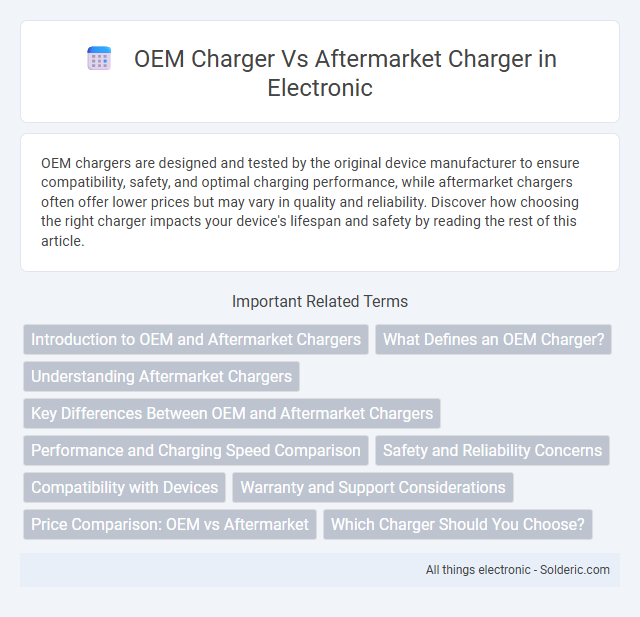OEM chargers are designed and tested by the original device manufacturer to ensure compatibility, safety, and optimal charging performance, while aftermarket chargers often offer lower prices but may vary in quality and reliability. Discover how choosing the right charger impacts your device's lifespan and safety by reading the rest of this article.
Comparison Table
| Feature | OEM Charger | Aftermarket Charger |
|---|---|---|
| Quality | High, manufacturer-tested | Variable, depends on brand |
| Compatibility | Guaranteed for specific device | May not be fully compatible |
| Price | Higher cost | Generally lower cost |
| Safety | Meets strict safety standards | May lack safety certifications |
| Warranty | Usually included with device | Often limited or no warranty |
| Charging Speed | Optimized for device | Can vary widely |
Introduction to OEM and Aftermarket Chargers
OEM chargers are manufactured by the original device makers, ensuring compatibility, safety, and optimal performance with specific devices. Aftermarket chargers are produced by third-party companies, often offering lower prices but varying in quality, safety standards, and device compatibility. Customers prioritize OEM chargers for reliable charging efficiency and warranty protection, while aftermarket options attract those seeking cost-effective alternatives.
What Defines an OEM Charger?
An OEM charger is defined by its manufacture from the original equipment manufacturer, ensuring precise compatibility, safety, and performance with the specific device model. These chargers undergo rigorous quality control and certification processes, maintaining adherence to industry standards and warranty requirements. OEM chargers are designed with proprietary technology and materials to optimize charging speed and protect battery health, distinguishing them from aftermarket alternatives.
Understanding Aftermarket Chargers
Aftermarket chargers often provide a cost-effective alternative to OEM chargers, but their compatibility and charging efficiency can vary significantly. These chargers may lack the precise voltage regulation and safety certifications found in OEM models, potentially impacting your device's battery life and performance. Understanding the specifications and reviews of aftermarket chargers is crucial to ensure reliable and safe charging for your electronic devices.
Key Differences Between OEM and Aftermarket Chargers
OEM chargers are designed and tested by the original device manufacturer to ensure optimal compatibility, safety, and performance with your specific product. Aftermarket chargers, while often more affordable, can vary widely in quality, potentially lacking proper certification and risking damage to your device or reduced charging efficiency. You should prioritize using OEM chargers for guaranteed reliability and adherence to your device's technical specifications.
Performance and Charging Speed Comparison
OEM chargers deliver consistent performance and optimal charging speed due to precise compatibility with device specifications and high-quality components. Aftermarket chargers may offer variable charging speeds and sometimes reduced efficiency, as lower-quality parts and less stringent standards can impact performance. Users seeking reliable fast charging should prioritize OEM options to ensure device safety and longevity.
Safety and Reliability Concerns
OEM chargers undergo rigorous testing and certification to meet specific safety and reliability standards, minimizing risks such as overheating, electrical faults, and device damage. Aftermarket chargers, especially those from uncertified manufacturers, often lack consistent quality control, increasing the likelihood of malfunctions and potential hazards like short circuits or battery degradation. Choosing OEM chargers ensures compliance with manufacturer specifications, promoting optimal device performance and long-term safety.
Compatibility with Devices
OEM chargers ensure optimal compatibility with your specific device by adhering to manufacturer specifications and safety standards, reducing the risk of damage or subpar charging performance. Aftermarket chargers may offer varying levels of compatibility, often lacking precise calibration for your device's voltage and current requirements, which can lead to slower charging or potential harm. Choosing an OEM charger guarantees seamless integration and reliable performance tailored to your device's needs.
Warranty and Support Considerations
OEM chargers provide reliable warranty coverage and dedicated customer support directly from the device manufacturer, ensuring hassle-free replacements and assistance. Aftermarket chargers often come with limited or no warranty, and support may vary significantly, increasing the risk if your charger malfunctions. Choosing an OEM charger safeguards your device's warranty and offers peace of mind through authorized service channels.
Price Comparison: OEM vs Aftermarket
OEM chargers typically cost significantly more than aftermarket chargers due to brand authenticity and quality assurance. Aftermarket chargers offer a budget-friendly alternative but may vary widely in build quality and compatibility. Consumers often weigh the higher price of OEM chargers against potential risks of lower-cost aftermarket options.
Which Charger Should You Choose?
OEM chargers deliver guaranteed compatibility, optimal performance, and reliable safety features tailored to your specific device. Aftermarket chargers often provide cost savings but can vary widely in quality, potentially risking device damage or reduced battery life. Choosing an OEM charger ensures manufacturer-backed support and preserves device warranty, making it the safer long-term investment.
OEM charger vs aftermarket charger Infographic

 solderic.com
solderic.com